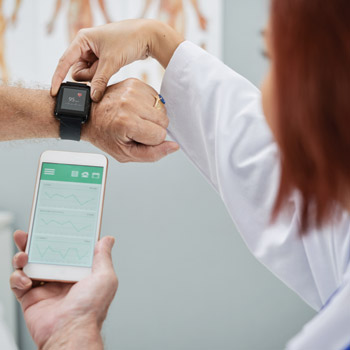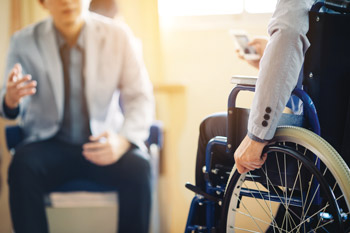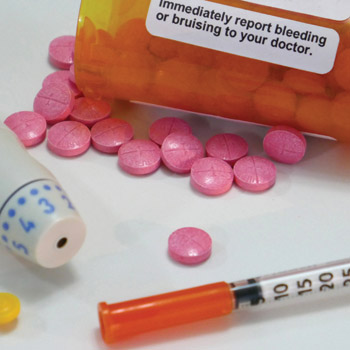Wrestling with wearables that screen for afib
Experts remain uncertain how to judge wearables and smartphone apps' cost-effectiveness, data quality, and clinical implications among pre-symptomatic patients diagnosed with atrial fibrillation.
It sounds like a wondrous medical device from science fiction: a watch that diagnoses heart problems before they're even noticeable.
In reality, however, the ability of wearables and smartphone apps to identify undiagnosed atrial fibrillation offers both benefits and challenges, according to experts at the American Heart Association's 2019 Scientific Sessions, held in Philadelphia in November.

They discussed data from the Apple Heart Study, published Nov. 14 in the New England Journal of Medicine, and other similar recent research, along with how the evidence shapes their thoughts about this potential screening method.
On the plus side, it could be a solution to the fact that many patients aren't diagnosed with atrial fibrillation until after they have a cardiovascular event. “I think we can agree that the diagnosis of afib before these sentinel events, whether it be ischemic stroke or systemic embolism, is an integral part of stroke prevention,” said Larry R. Jackson II, MD, assistant professor of cardiology at Duke University in Durham, N.C.
On the other hand, even experts are still uncertain how to judge the technology's cost-effectiveness, how to handle the quantity of data provided, and even how to treat patients diagnosed with atrial fibrillation before they have any symptoms.
“We know the treatment of known [afib] or conventionally diagnosed [afib] reduces stroke risk. Whether or not the same benefit is associated with early diagnosed [afib] remains unproven,” said David McManus, MD, professor of medicine at the University of Massachusetts in Worcester.
How it works
In judging the value of afib detection by wearables, it's useful to understand how it happens. The most commonly used technology is called photoplethysmography (PPG). “Essentially, it's a low-cost optical technique that's used to detect blood volume changes in the microvascular bed of tissue,” said Dr. Jackson. “Its widespread clinical application is in things like pulse oximetry, various vascular diagnostics, and blood pressure and cardiac output measurement.”
The wearables use the fact that blood is red and therefore reflects red light and absorbs green light, he explained. “Increases in blood flow in the wrist lead to increases in green light absorption during the heartbeat,” said Dr. Jackson. “So by flashing the LED lights hundreds of times per second, the Apple Watch can count the number of times your heart beats per minute. The times between each PPG signal repeats are recorded as intervals between pulses.”
The effectiveness of this method has been supported by research, noted Dr. Jackson, citing a study that used a smartphone camera to identify atrial fibrillation. According to results published in the American Journal of Cardiology on May 15, 2018, a mobile app using the camera correctly identified atrial fibrillation in 94 of 101 patients who did have it and reported normal results in 80 of 88 patients without it.
This is the main, but not only, technology being used to identify atrial fibrillation out in the world rather than in clinical practice. Another method is to use a specific device in combination with smartphones to come closer to providing an electrocardiogram (EKG). One such example is the AliveCor Kardia.
“What happens here is the index and middle fingers of both hands are placed on these pads, and through communication with the smartphone and mobile app are able to recreate the EKG,” Dr. Jackson said.
He added that given the large quantities of data generated by these devices, another technical innovation is going to be helpful for finding patterns and sorting information—artificial intelligence.
“Wearables are here to stay, and they are demonstrating promise with respect to the detection of atrial arrhythmias and atrial fibrillation. I think we should recognize that older technologies such as PPG are being combined with subsets of artificial intelligence to potentially change our outcomes for disease processes,” Dr. Jackson concluded.
Watches and other wearables
One of the biggest demonstrations of the technology so far is the Apple Heart Study, which was funded by Apple and included more than 400,000 Apple Watch wearers. Most simply downloaded an application and consented to the study, and then their watch and phone took one-minute tachograms every two hours or so.
“If there's an irregular tachogram detected, then the checks are a little bit more frequent. And if five out of six consecutive checks are irregular, then the user is notified that there might be an irregular heartbeat,” explained the study's lead author, Marco V. Perez, MD, associate professor of cardiology at Stanford University in California.
The 2,161 participants who were notified of an irregular pulse (0.52% of the total) were connected to a doctor and offered an EKG patch to wear for a week. Four hundred fifty patients used and returned the EKG patch, and in about a third of them, it indicated atrial fibrillation.
Dr. Perez noted that the study's volunteers were not the population in which atrial fibrillation would be most commonly expected. “About 52% were less than 40 years of age,” he said. Not surprisingly, atrial fibrillation was detected significantly more frequently among the 24,000 patients who were age 65 years or older: a rate of 3.1% compared to 0.16% of those ages 22 to 40 years.
But it's significant that afib was also found in younger patients, with obesity and hypertension as associated factors. “We were still seeing very young people with irregular pulse,” Dr. Perez noted.
Another interesting finding was the variation in the intensity of afib. “In those who had atrial fibrillation, 20% of them had atrial fibrillation all the time, whereas everybody else had a much lower burden overall, most of them falling below 50%,” he said.
One challenge of the study was how many participants couldn't continue to the EKG patch step because they turned out to have already been diagnosed with afib, despite that being a criterion for study exclusion. “Maybe they were just curious,” said Dr. Perez. “When they got notified, they said, ‘I already know I have atrial fibrillation.’”
Identifying the right population to screen is a major issue in wearable afib research, explained Prashanthan Sanders, MD, director of the Centre for Heart Rhythm Disorders at the University of Adelaide in Australia.
He highlighted other recent research in the field, such as the mSToPS study, published in the July 10, 2018, JAMA. That trial, which was partially funded and conducted by Janssen Pharmaceuticals, included more than 2,000 patients and screened for afib using a patch that provided continuous EKG monitoring for up to four weeks. “In a high-risk group of patients, they were able to show a 3% increased chance of detecting atrial fibrillation during that follow-up period,” said Dr. Sanders. In that study, 15% of those with afib had an episode lasting more than 24 hours.
Another trial, which used an app to screen volunteers recruited by a Belgian newspaper ad, found atrial fibrillation in 1.1% of the population, according to results presented at the Heart Rhythm Society's 40th Annual Scientific Sessions in May 2019. These results also suggested that screening might need to be more targeted, since age, male gender, weight, and body mass index were associated with more frequent afib, Dr. Sanders said.
Uncertain effects and costs
In addition to figuring out which patients are more likely to have atrial fibrillation detected by devices, researchers will have to understand the consequences for them. Dr. Sanders and colleagues gathered some data relevant to this question using the original wearables—pacemakers and implantable defibrillators.
In a meta-analysis published in the European Heart Journal on Jan. 10, 2018, they looked at the risk of stroke and symptomatic afib in patients who had subclinical atrial fibrillation detected by their implanted devices. “There's a 2.4-fold increased risk of stroke, which is much less than we've seen in traditional populations with atrial fibrillation. So we're dealing with a lower burden, and we need to work out how we advise on anticoagulation when we have this population,” Dr. Sanders said.
The burden of the afib cases detected by smartphones and watches might be even less than that detected by implanted medical devices, according to Dr. McManus.
“Patients with pacemakers and implantable loop recorders are different from ambulatory patients who do not require these devices,” he said. “We need to conduct studies to establish both the stroke risk and potential benefit of treatment associated with early detection of afib, as this may be a different disease or an earlier stage of the disease.”
A possible benefit of early detection and treatment is that they could reduce the risk of heart failure among patients with afib. “We're really talking about diagnosing atrial fibrillation early on when cardiac remodeling would presumably be less far along. I think there's an opportunity for us to bend the curve of normal aging-related substrate changes to the atrium through aggressive afib risk-reduction strategies,” Dr. McManus said.
Such strategies could include reductions in alcohol use, weight loss, or hypertension control, as well as anticoagulation or ablation, he suggested. “To be frank, however, we have very little data to suggest that early diagnosis actually will reduce risk of stroke or heart failure at this point. They need to conduct studies to prove this hypothesis,” Dr. McManus said.
To learn about the effects of early detection, he and his colleagues are currently conducting a randomized trial screening patients older than age 65 years who are seen in their health systems' primary care clinics. “The primary outcome will be the rate of [afib] diagnosis, but we also will follow for rates of anticoagulation initiation, new ischemic stroke, and heart failure, as well as rates of major hemorrhage,” Dr. McManus said.
He predicts that older patients, and others with risk factors, will turn out to be the optimal population for screening. “I think we would want to constrain it to patients at highest risk first, to avoid issues around misdiagnosis. There's potential risk of harm. There's also risk of anxiety associated with the diagnoses that are real,” he said. “I think we have to take that point very seriously.”
Another challenge will be getting patients from device-detected issues to treatment. “If providers are not engaged in this process, there are lost opportunities to engage in treatment,” said Dr. McManus. “If no treatment, no benefit.”
Of course, treatment carries costs, and there are economic and utilization issues to be considered before device screening is widely applied, according to Paul A. Heidenreich, MD, professor of cardiology at Stanford University. “How much is this actually going to cost us to do this work?” he asked.
In pursuit of an answer, he reviewed the downstream effects of the atrial fibrillation cases detected in the Apple Heart Study. More than two-thirds of the patients who were warned about an irregular rhythm then saw a physician, either within the study or outside it, and 28% were started on a new medication within 90 days.
“A third were referred off to a specialist like the cardiologist and 36% underwent additional testing,” Dr. Heidenreich said. At the end of the study, patients were surveyed, and 404 of them reported having been newly diagnosed with atrial fibrillation, leading to a variety of additional treatments, including 95 who got cardioversion, 12 who received an implantable loop recorder, and 71 who received catheter ablation.
“I think what's concerning is there were two for every 10 [newly diagnosed patients] who had a pacemaker put in,” he said. “Supposedly at least, starting the study they didn't have an indication for a pacemaker as best we knew.”
Cost-effectiveness is primarily judged by the cost of treatment compared to its benefit in quality-adjusted life-years, he noted. By that standard, treatment for atrial fibrillation is high value, because anticoagulation, the most common treatment, is not expensive compared to the benefit it provides.
“However, if we are going to be screening, we need to add in the screening cost,” Dr. Heidenreich said. The cost of screening with devices does not appear that high (about $116 per patient in the Apple Heart Study, he reported). “But then there's the other issue that I think we really don't have a good handle on, and that is the incidental findings,” he said. “There are some reasons to think there will be a lot of extra care provided.”
EKG patches that are given to patients after an irregular rhythm is detected can lead to all sorts of other findings, including premature ventricular contractions and nonspecific, nonsustained ST changes, according to Dr. Heidenreich. “We're going to have a lot of findings here that will result in additional testing, because of the concern that we just cannot ignore some of these results,” he said.
Currently, a lot of variation and uncertainty is expected in how physicians respond to afib detected by a wearable, as is the case for many existing test and imaging results, he said. “We should actually have some documents somewhere saying, ‘This is how you would handle all the possible findings we might put out in a report.’”
Guidelines and pathways
No advice on wearables exists in current U.S. guidelines on atrial fibrillation, according to Sana M. Al-Khatib, MD, a professor of medicine and an electrophysiologist at Duke University in Durham, N.C.
“Really, there isn't anything specific to wearables,” she said. The closest the latest update from the American Heart Association, American College of Cardiology, and the Heart Rhythm Society comes to relevant guidance is a recommendation that atrial high-rate episodes detected by implanted devices should prompt further evaluation, she said.
European guidelines do directly address the question of afib screening. The European Society of Cardiology recommends opportunistic screening by pulse taking or rhythm strips in patients older than age 65 years. “But then if you look at systematic [electrocardiography] screening, they say it may be considered to detect afib in patients older than 75 years of age or those who are at a higher risk of stroke,” said Dr. Al-Khatib. “In most cases, they're telling you not to do it.”
The U.S. Preventive Services Task Force has also looked at whether to use conventional EKG to screen for afib. “They concluded that there was inadequate evidence to assess whether screening with an EKG identifies older adults with previously undiagnosed atrial fibrillation and that that's more effective than usual care,” she said. “They actually called for randomized trials enrolling asymptomatic individuals that directly compare screening with usual care and that assess both health outcomes as well as harms.”
There are a lot of questions for such research to answer. “What we do not know is if treating those episodes in patients with undiagnosed or silent afib actually improves their outcomes,” she said. “Should a five-second episode prompt treatment? Or a six-minute episode?”
Some answers should be forthcoming fairly soon, she predicted. “There are a lot of ongoing studies and I'm sure that as we have more evidence and more definitive data, we'll see that the guidelines will be updated and hopefully we will be able to change practice and improve patient outcomes,” Dr. Al-Khatib said.
However, if afib screening by wearables is proven beneficial for patients, there will be at least one more major hurdle—widespread implementation. These devices would generate enormous quantities of data in need of interpretation and response.
“To do this on a mass scale, it's going to be beyond what we can handle with the current infrastructure,” said Dr. Perez. He noted that CMS has created a code to reimburse clinicians for reviewing data from a wearable device, although his practice has not yet used it.
Clinicians and practice leaders should start thinking about the pathways they'll use to care for these patients before they show up with data from wearables, advised Dr. Al-Khatib. “Usually the way it works is we wait until we get overwhelmed and inundated, and then at that point we create a solution. Hopefully we can be a bit more proactive and try to start implementing the necessary care pathways soon,” she said.





